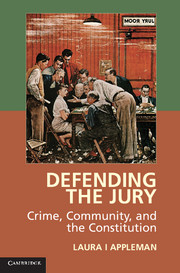Book contents
- Frontmatter
- Contents
- Acknowledgments
- 1 Introduction
- Part I History in the Crucible: Rediscovering the Original Community Right in Criminal Justice
- Part II Old Becomes New: Sixth Amendment Jury Rights and Twenty-First-Century Criminal Procedure
- Part III Theory into Practice: Origins and Community in Modern Criminal Procedure
- 6 Bail, Jail, and the Community Voice
- 7 Infusing Community through Criminal Procedure: The Plea Jury
- 8 Eradicating the Bench Trial
- 9 Restoring the Offender to Society
- 10 Back-End Sentencing: The Sixth Amendment and Post-Prison Procedures
- 11 Jury Nullification and Victim Rights: Going Past Procedure
- 12 Conclusion
- Selected Bibliography
- Index
- References
9 - Restoring the Offender to Society
Published online by Cambridge University Press: 05 April 2015
- Frontmatter
- Contents
- Acknowledgments
- 1 Introduction
- Part I History in the Crucible: Rediscovering the Original Community Right in Criminal Justice
- Part II Old Becomes New: Sixth Amendment Jury Rights and Twenty-First-Century Criminal Procedure
- Part III Theory into Practice: Origins and Community in Modern Criminal Procedure
- 6 Bail, Jail, and the Community Voice
- 7 Infusing Community through Criminal Procedure: The Plea Jury
- 8 Eradicating the Bench Trial
- 9 Restoring the Offender to Society
- 10 Back-End Sentencing: The Sixth Amendment and Post-Prison Procedures
- 11 Jury Nullification and Victim Rights: Going Past Procedure
- 12 Conclusion
- Selected Bibliography
- Index
- References
Summary
This chapter, along with Chapter 10, discusses how we can use expressive restorative retribution as a framework to address the problems inherent in the punishment imposed both before and after conviction. The insertion of a community voice into these pre- and post-conviction, or “ancillary,” sentences provides a concrete way of implementing a form of expressive, restorative retribution that provides a slice of civic engagement and an improved reentry experience for both the offender and her community.
Not only does expressive[,] restorative retribution give the community a voice and help foster egalitarian and democratic ideals, at its best, it also forces offenders to take more responsibility for their wrongdoings, since the community is involved in the imposition of punishment and restoring the balance disturbed by the offender’s bad acts. This type of community involvement is the much-needed step that has long been missing from our punishment in general, but particularly from our nonprison and post-punishment schemes.
Using expressive restorative retribution as a punishment philosophy for ancillary sentencing provides a concrete policy of community involvement and participation to a much-ignored and neglected area of the criminal justice system – a sphere that invariably touches every single offender. Taking a page from the past, Chapters 9 and 10 argue that community involvement can help structure nonprison ancillary sentencing, giving guidance not only to the players in the criminal justice system, but hopefully to the legislative and executive branches as well.
- Type
- Chapter
- Information
- Defending the JuryCrime, Community, and the Constitution, pp. 172 - 190Publisher: Cambridge University PressPrint publication year: 2015



